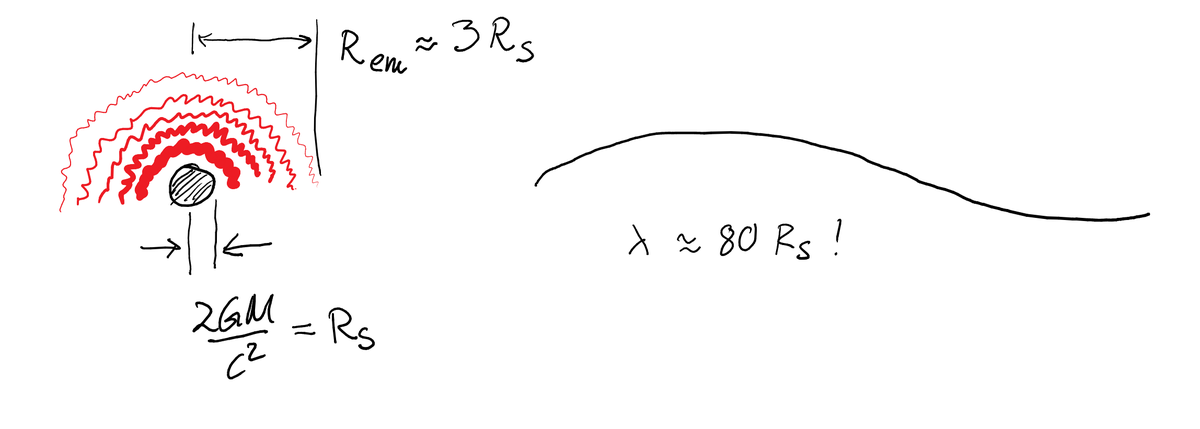Ok, since people were asking… Here's an easy way to see that Hawking radiation is not due to particle–anti-particle pair at the horizon. First thing to remember is a that a black hole is not a point, it has a size: its Schwarzschild radius Rs~2GM/c^2 (figure below)
1/
1/
We'll measure other lengths in terms of this distance. It turns out that there is a whole region of space close to a black hole that's responsible for emitting the Hawking radiation. It doesn't have a sharp cutoff—there is a density that goes down farther away from the BH. 2/
This emitting region also has a characteristic size, and it is linearly proportional to the Schwarzschild radius. In fact, the radius of the emitting region if roughly 3 times the Schwarzschild radius. 3/
The other length scale to keep in mind is the typical wavelength of Hawking radiation that comes out. It's a blackbody spectrum, so there is a whole distributions of wavelengths, but again there is a typical size. It's also linearly proportional to the Schwarzschild radius! 4/
The coefficient here is roughly 80, though. Yes, the Hawking radiation has a wavelength that's roughly 80 times the radius of the black hole! No wonder we can't pin it down to coming from somewhere on the horizon—it can't fit. 5/
The astute reader will have by now said "Aha, I've caught you in a lie! You said it came out of a region with radius ~3Rs! Surely it can't fit in there!" Very good point, dear reader. There is a gravitational redshift effect that means 6/
that the radiation started out with a shorter wavelength when it was closer to the black hole. Now our clever reader says "Well then, the closer to the horizon you go, the shorter the wavelength! No problem, it could have come from the horizon after all." 7/
This kind of thinking runs into something called the trans-Planckian problem. If you take this thinking all the way, the radiation could have started at the Planck length, where you need a quantum theory of gravity to describe nature—and we lack one. 8/
We really don't want Hawking radiation to depend on ultra-high energy physics! I much prefer to think of the emission as coming from some coherent physics happening over the ~3Rs around the black hole, instead of at the horizon. 9/
This point of view is more like building an optical cavity to build up the strength of a laser beam. A laser beam has a specific wavelength, and you can build a resonant cavity that is a multiple of this wavelength. When you put in a beam of light, it bounces back and forth… 10/
and it's the *entire* cavity that's responsible for building up the amplitude of the laser. Similarly, it's the entire region around the black hole that's responsible for making the Hawking radiation. 11/
So, maybe we can think of Hawking radiation as the gravitational field creating a (not really resonant, and very leaky) cavity. 12/
The big difference between the classical optical cavity and Hawking radiation coming from a black hole is what you need to put in to get something out. In the optical cavity, you put in a classical light wave and you get out another classical light wave. 13/
We can also have a quantum mechanical optical cavity, and that is arguably more like the black hole. With the black hole, there is a certain state of all the quantum fields going in, and a different state of all quantum fields going out. 14/
If you've taken quantum mechanics or even linear algebra—there is a linear transformation (essentially a change of basis!) between the in state and the out state. 15/
Here's what's bananas about a black hole. If you make the input state the /vacuum/ state, what comes out is *not the vacuum*!!
16/
16/
There is a detailed calculation—which involves calculating something called the Bogoliubov transformation between these two bases—that lets you calculate the Hawking radiation.
Nowhere in this calculation are there any 'particle–anti-particle pairs being torn at the horizon' 17/
Nowhere in this calculation are there any 'particle–anti-particle pairs being torn at the horizon' 17/
(Getting technical, sorry) I think the real shift in thinking that's needed to understand this calculation is that the in-state and out-state live in two different Fock spaces. The transformation between them need not be unitary, and indeed is not. 18/
Anyway, the "gravitational laser cavity" idea is the best mental picture I've got so far, even though it's still nowhere close to expressing how the Bogoliubov transformation calculation works.
19/20
19/20
The Bogoliubov calculation is nonlocal, maybe we just can't capture it with a nice picture with events happening at specific places! We're still thinking too classically, and too locally. Free your mind 
20/20

20/20
Footnote: if you want a handy reference for the size of the emission region and the wavelength, try Steve Giddings' article, "Hawking radiation, the Stefan-Boltzmann law, and unitarization"
https://arxiv.org/abs/1511.08221
https://arxiv.org/abs/1511.08221

 Read on Twitter
Read on Twitter


